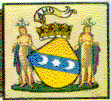![]()
A Short Scott Family History
To the list of some books of interest.
A short history from
The Book of Scottish Clans
by Iain Zaczek
and Illustrated by Jacqui Mair, pages 108-111.
SCOTT
IN c.500 AD, a group of Irish tribesmen migrated from northern Ireland to Argyllshire, where they founded the kingdom of Dalriada. The Latin name for this Celtic people was the Scotti or Scoti. In due course, they gave their name to Scotland, when the Scottish and Pictish crowns merged, under the strong leadership of Kenneth MacAlpin in c.843.
As a surname, Scott first became popular in the Border region, where it denoted a Scotsman, just as Inglis indicated an Englishman. The earliest documentary evidence dates back to the 12th century, when Uchtredus filius Scoti (Uchtred, son of the Scot) witnessed the foundation charter of Selkirk (c.1120). He had two sons, who are generally regarded as the ancestors of the two main branches of the clan - the Scotts of Buccleuch and Balweary.
The name of Buccleuch was first adapted by Sir Richard Scott, who acquired the lands of Murthockstone through marriage, and the estates of Rankiburn through his role as Ranger of Ettrick Forest. The 2nd Laird of Buccleuch was a hero of the Battle of Halidon (1333), but it was the 9th Laird who consolidated the family's position, when he became Warden of Liddesdale and the Middle Marches in 1551.
During the 17th century, the Scotts of Buccleuch rose to even greater heights, becoming in succession Lords (1606), Earls (1619), and Dukes (1663). Their wealth and position was reflected in a remarkable art collection, which can now be seen at the great houses of Drumlanrig and Bowhill.
The most famous Scott of all, however, came from a secondary branch of the clan. Sir Walter Scott (1771-1832) was descended from the Scotts of Harden. He is mostly remembered today as one of Scotland's greatest poets, writers, and folklorists, although devotees of tartan also have good cause to remember him with affection. For Scott played a major part in making Highland dress fashionable once more when he organized George IV's visit to Scotland (1822).
The Latin name for a group of Irish tribesmen in 500 AD was Scottis
THE LEGEND OF SCOTT
THERE IS A CURIOUS LEGEND about the origin of the Scoti, which was first recounted in the Irish Lebor Gabala ("Book of Invasions") and repeated much later in Hector Boece's Chronicle of Scotland (1526). According to this, they took their name from Scota the daughter of a pharaoh, who married a warrior named Mil. Together they travelled to Spain, where Mil died in battle, while Scota journeyed on to Ireland with her eight sons. Eventually, their descendants migrated to the west coast of Scotland where they founded the kingdom of Dalriada.
Many legends also surround the figure of Michael Scot the Wizard (c. 1175-1235), even though he was a genuine historical character. In reality, he was a scholar, scientist, and philosopher, who translated texts from Aristotle and wrote on such diverse topics as medicine, meteorology, and astronomy. Like many scientists of the period, however, he also dabbled in the study of alchemy and magic, and it was these esoteric subjects which earned him the nickname of "wizard." Dante included him among the damned who dwelt in his Inferno, while Scottish folklorists concocted a wide selection of tall stories about his magical powers.
It is said, for example, that Michael owned a magical horse who could fly faster than the wind. On one occasion they traveled to Paris, where the beast stamped its hooves, causing every church-bell in the city to ring; on another, he flew from the icy north to Rome, where the pope was astonished to find that the beast was covered in snow. According to the storytellers, Scott also had a team of demons, who did his bidding. He set one of these to split the Eildon Hills, another to dam the River Tweed, and a third to spin rope out of the sand, which lay on its banks.
The following page was excerpted from
- How the Scots Invented the Modern World, by Arthur Herman
- Tracing your Scottish Ancestors, by the Scottish Record Office
- John Barbour - The Bruce, The Prose Translation by George Eyre-Todd
- Periods in Highland History, by I. F. Grant and Hugh Cheape
- The Original Scots Colonists of Early America: Supplement 1607-1707, by David Dobson
If you want to learn about the Celts, then look for:
- Who Were The Celts?: Everything you Ever Wanted to Know About the Celts 1000 B.C. to the Present, by Kevin Duffy
I also have an array of pocket books about the Scottish Kings and Queens, Scottish Battles and The History of Scotland.
This is the line that's most touched my interest, but I'm no where near an expert. I've been very fortunate to have been able to visit Scotland numerous times, mostly to play golf near St. Andrews and Carnoustie, but my last trip fortunately was to visit Glasgow.
Click here for some pictures of Scotland.
Some Scott Clan items of interest:

Red Tartan

Scott Coat of Arms

Scott Family Shield
![]()
This page was last updated on 10/07/2006
![]()
Add your text here. Be sure to read all of the pages in this template before
you change or delete them. We have included a lot of helpful information.
The "What's New!" and "Our Pages" images were done in 18 pitch Black Adder ITC Font.

